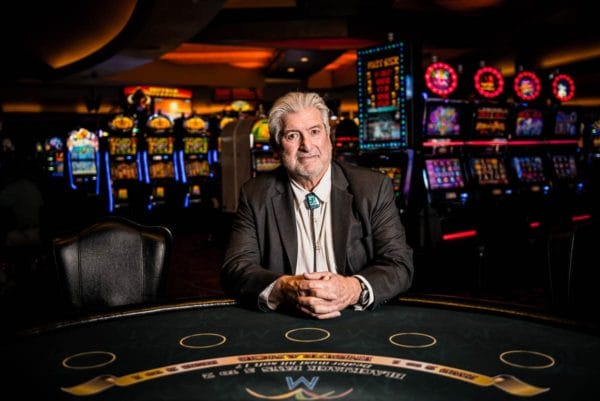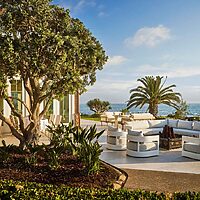Tribal Chairman of the Morongo Band of Mission Indians Robert Martin Shares How the Morongo Band of Mission Indians Came to Own and Operate Morongo Casino
Out in the desert, sunrises and sunsets light up the San Gorgonio and San Jacinto Mountains in vibrant hues. The winds echo with laughter near Morongo Casino Resort & Spa, where history runs deep. The Morongo Band of Mission Indians have lived here for over 5,000 years, back when this land was a vast water bed. In 1876, President Grant set aside reservation land, but the Morongo people stayed on their ancestral home. Fast forward to 2004, they opened the Morongo Casino Resort & Spa, becoming pioneers in tourism. Their success helped lead Native tribes across the country toward self-reliance and prosperity.
The peace-loving Morongo tribe has always been a natural fit for the terrain. Despite the harsh desert, the Morongo people adapted and thrived by using the natural and man-made resources around them. They evolved with the times, improving their quality of life through resilience and innovation. Morongo Casino Resort & Spa became the first premier gaming resort run by Native American Indians. Today, it’s more than a casino—it’s a full entertainment hub. Guests can enjoy a bowling alley, spa, and even the first In-N-Out ever built on a reservation.
Chairman Robert Martin, head of the Morongo tribal government, who was first elected tribal chairman at age 32, remembers their turning point well when the landmark 1987 U.S. Supreme Court victory confirmed the sovereignty of Indian tribes and their right to establish gaming operations.
A visionary, Martin worked on its passage and the development of his tribe’s original resort and casino. Then in 2004, he spearheaded the development of the $250-million casino, resort and spa complex in Cabazon, adjacent to Highway 10.
Q: Can you describe the land and how it has evolved over your lifetime?
Robert Martin: I remember vast expanses of chaparral and fields of poppies. Pines and streams with running water. There were ranches with cattle and orchards that grew peaches and almonds groves. Around the late ’50s, agriculture fell off and many jobs were lost, especially in the construction industries. There were hard times on the reservation because it was economically depressed. But, we are a very spiritual tribe and believe in self-reliance.
Q: Why did you choose gambling as an economic solution for the economically depressed Morongo Band of Mission Indians?
RM: We knew we needed to create jobs to create a better life for our people. It is hard to make a living on most reservation lands. Most of it is undesirable real estate. There was a small casino operating on our reservation as early as 1983 and it did quite well, but its revenues were managed by one individual and not shared with the tribe—which is not how we function in a tribe. In 1987, when the U.S. Supreme Court approved the Indian Gaming Regulatory Act—providing a legislative basis for the operation and regulation of Indian gaming and serving to protect gaming as a means of generating revenue for the tribes—it encouraged us to lead in the economic development for all Native American Indians.
With the passage of the act, we were able to realize our dream of self-reliance and self-determination.
Q: Did you encounter any opposition after its passage?
RM: No, we were able to move pretty quickly. Everything we do is done by consensus with the other tribes. There was only one tribe, the Navajo Tribe, that didn’t support taking private reservation land and turning it into public-use gambling resorts. Their concerns were that it could alter the integrity of the Native American Indian culture.
Q: What went into the making of your $250-million casino resort and complex?
RM: We wanted to incorporate our philosophy and natural elements found in the landscape. The resort is still the tallest building in the area at 27-stories high. Our architect was John Jerde, who also designed The Bellagio in Las Vegas. We really like his use of curves in his design style. Inside, we wanted to convey the “motion of art” to our guests as they wind their way around the public areas. Our lobby entrance, which is called Blossom, represents one of the flowers from our native flora.
We wanted it to look like it’s floating out of the desert floor.
We have a very popular bowling alley and recently opened our 36-hole champion golf course at Tukwet Canyon and will be hosting golf tournaments there this year. Because we care so greatly about the environment, we have programs in place that recycle, reuse and reduce our carbon imprint and are continually updating the property with ecology in mind.
Q: How has life improved for the Morongo Native American Indians since the resort opened?
RM: It has literally transformed the lives of tens of thousands of Native Americans across the nation by creating opportunity and hope which brings me great pride. In our own community, the resort provides more than 3, 000 jobs, generates over $3 billion in regional economic activity and continues to sell out every weekend. With these revenues, we are able to provide community enrichment programs for our community. Since 2010, we have donated more than $550, 000 towards annual shopping sprees for low-income children across Inland Southern California and last year, we contributed $250, 000 to aid victims and families impacted by the San Bernardino terrorist attack.
We have donated over 100, 000 turkeys to 125 nonprofit organizations, churches, homeless shelters, schools and veteran groups that provide 1.5 million holiday meals.
Q: What’s on the horizon in terms of creating opportunity and hope for your people?
RM: We want to cultivate the next generation of tribal leaders. Last year, we awarded $10, 000 scholarships to four Native American students from California. The scholarship is unique among tribal scholarship programs because it is open to any enrolled member from more than 100 federally recognized tribes in California. We also hosted the first Indian reservation moot court competition with our students and won both of the competitions. This forum helps encourage Native American students to pursue a university education.
Q: Your tribe has quite an expansive business portfolio with new ventures in finance, healthcare and agriculture. Any new developments for tourism in 2016?
RM: We are scheduled to open the Hadley Fruit Orchards new store in early 2016. We are excited and proud to continue to build upon the tradition of what was a desert oasis stocked with dried fruits and nuts, wine, honey, vitamins and gift items and will be adding fresh fruit, home-baked bread and healthy pizzas.
All In the Cards

Gaming has always been a part of Indian culture in archery competitions and rice, dice and shell games.
A Little Dated
The original Hadley Fruit Orchards was a stand that became a store and is famous for date shakes, delicious sandwiches and their celebrity photo wall.
School Ties
Chairman Martin is dedicated to shaping future tribal leaders. He helped create a tuition-free prep academy on the Morongo Reservation. It’s the first academy of its kind in the nation, offering education and opportunity to the next generation.
The Works
The casino ranks among the largest tribal gaming centers in the U.S., offering slots, tables, and high-limit gaming. It also features five top-rated restaurants, a world-class spa, nightclub, bowling alleys, and a pool with private cabanas. Legendary entertainers are booked regularly for live shows and concerts.
The Morongo Band of Mission Indians
12700 Pumarra Rd
Banning, CA 92220
951.849.4697
Morongo Casino Resort & Spa
49500 Seminole Dr
Cabazon, CA 92230
951.849.3080
Photographed By: Julie Jones.
Written By: Robyn Wyman-dill
Journalist Robyn Wyman-Dill resides in Monarch Beach. She received her BS from the University of Colorado and completed her journalism studies at Saddleback College in 2010. Blessed with ample curiosity and a passion for knowledge and the arts, she loves to travel and has lived in London, Florence, and Germany.
rjwdcreative.com
#rjwdcreative
@rjwdcreative
- Robyn Wyman-Dill
- Robyn Wyman-Dill























